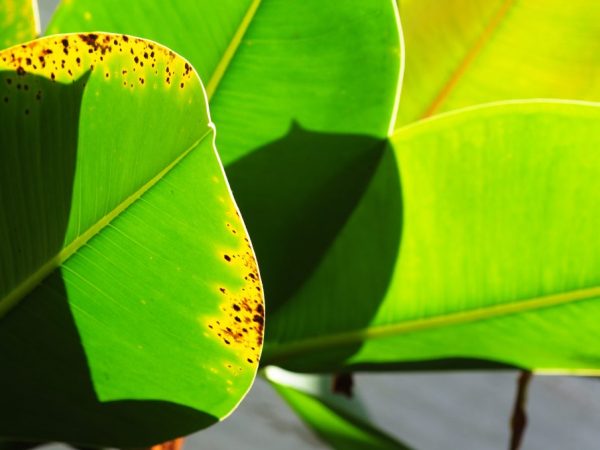Reasons for the appearance of spots on the ficus
Ficuses are unpretentious plants that do great at home. However, sometimes, due to improper care or proximity to infected flowers, ficuses can get sick. There are several reasons why spots appeared on the leaves of the ficus.

Spots on ficus leaves
Reasons for the appearance of stains
The appearance of brown spots on the ficus usually means that the flower is infected with something. But there are other factors that cause rusty, dark or light spots on the leaves of the ficus.. This process can cause the age of the flower, its location in the apartment. Among the reasons are also distinguished:
- poor-quality lighting, due to which the bush does not receive the required ultraviolet light;
- a small percentage of air in the room, due to which the root system does not receive the required percentage of oxygen;
- improper watering;
- shortage of nutrients;
- poor quality soil (the crown becomes sticky and becomes covered with yellow, white or brown spots).
- improper watering: you can not overdry the land in which the ficus grows, or overmoisten it.
It is best to put the pot in a sunlit place, since the ficus is light-requiring. In this case, direct sunlight should be avoided so that the plant does not get burned.
Pests and diseases are another problem that can cause yellowing of the crown, the appearance of black dots on the leaves or brown spots on the stem and leaves of the ficus.
Stains and yellowing
Yellow leaves appear due to the low humidity in the room. Most often, this phenomenon is observed in the cold period: the room is heated, due to which the air is greatly dried. The plant can be especially badly damaged if it stands next to a device that generates heat (fan, battery). This is the reason why the flower pot should be looked for elsewhere during the heated period. The leaves can also become sticky.

Dry air is bad for the leaves
Another precaution is to spray the leaves regularly with a spray bottle. If the plant has already been damaged, to reanimate, it must be sprayed every 6 hours.
The second factor that can affect the bush is the stress experienced. To avoid this effect, it is advisable to find the optimal location for the pot, and not drag it from place to place.
Falling leaves
If the leaves and stem of the flower begin to turn yellow and then fall, the root system lacks nutrients and trace elements. In such a situation, there is only one way out: transplant the flower into a new pot. You should purchase soil with a peat base, leafy soil and, of course, sand.
Falling yellow leaves may also indicate that there is too much water in the soil, which means that the root system takes excess water and eventually begins to rot. To prevent this from happening, the ground should be watered only when the soil dries out at least 3 cm from the surface. If you give the plant too much water, it can dry out.
If the leaves began to fall off very strongly, the flower must be urgently transplanted, but before that it is necessary to cut off all the dead and rotten roots, let them dry out.
Falling leaves at the bottom of the trunk
If the leaves have fallen at the bottom of the trunk, the bush is already aging.
If the ficus is young, but began to lose leaves from the base of the stem, the transfer rates were violated. To restore a flower, it must be transported to new soil.
Prophylaxis
To prevent black, brown and white spots from appearing on the leaves, time should be given to prevention. It starts with taking proper care of the plant.
Ficus loves water, but it cannot be poured - the soil must be watered when it dries up a little. To understand how dry the earth is, you need to take a fork, stick it into the ground, loosen it slightly. If it is about 3 cm dry, the soil can be moistened. It is ideal to water the flower once a week, no more and no less. When it's hot - 2-3 times a week. All the water flowing from the pot into the stand must be poured back into the bush.
At the first appearance of brown spots and stickiness on the leaves, the flower must be washed.
To give the flower beauty and originality, it should be constantly pruned. Today there are several types of pruning: pyramid, arch, etc. Thin branches and those that do not give leaves must be removed immediately. Cut and pluck the flower, preferably 2-3 times a year.
If you keep the ficus correctly and keep it away from drafts and dry places, the risk of death will decrease by 2 times. It is also necessary to adhere to the rules for transplanting ficus so that it does not die.


